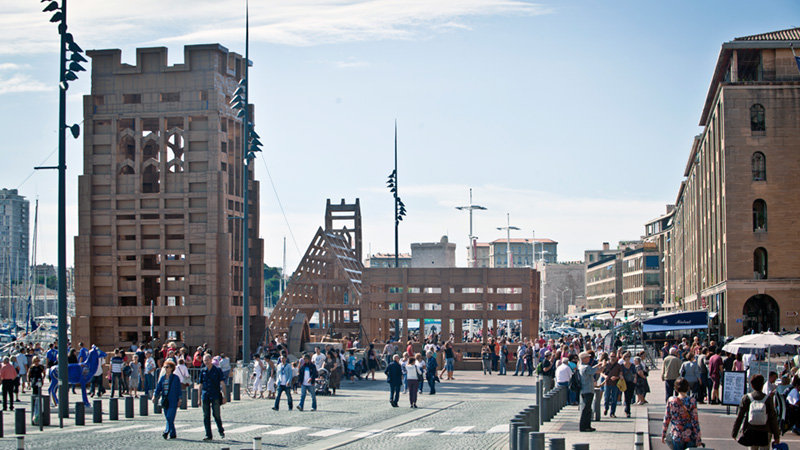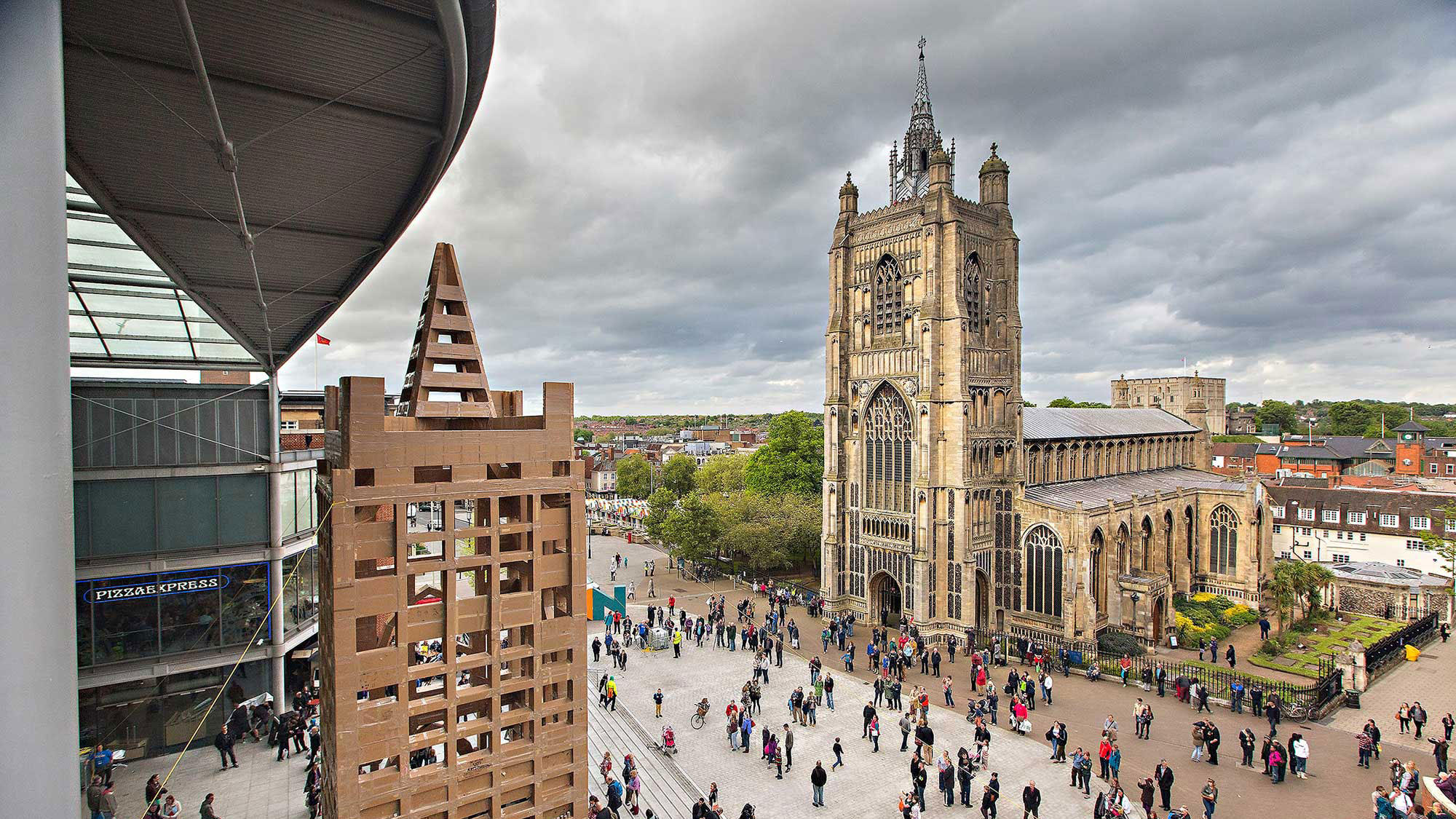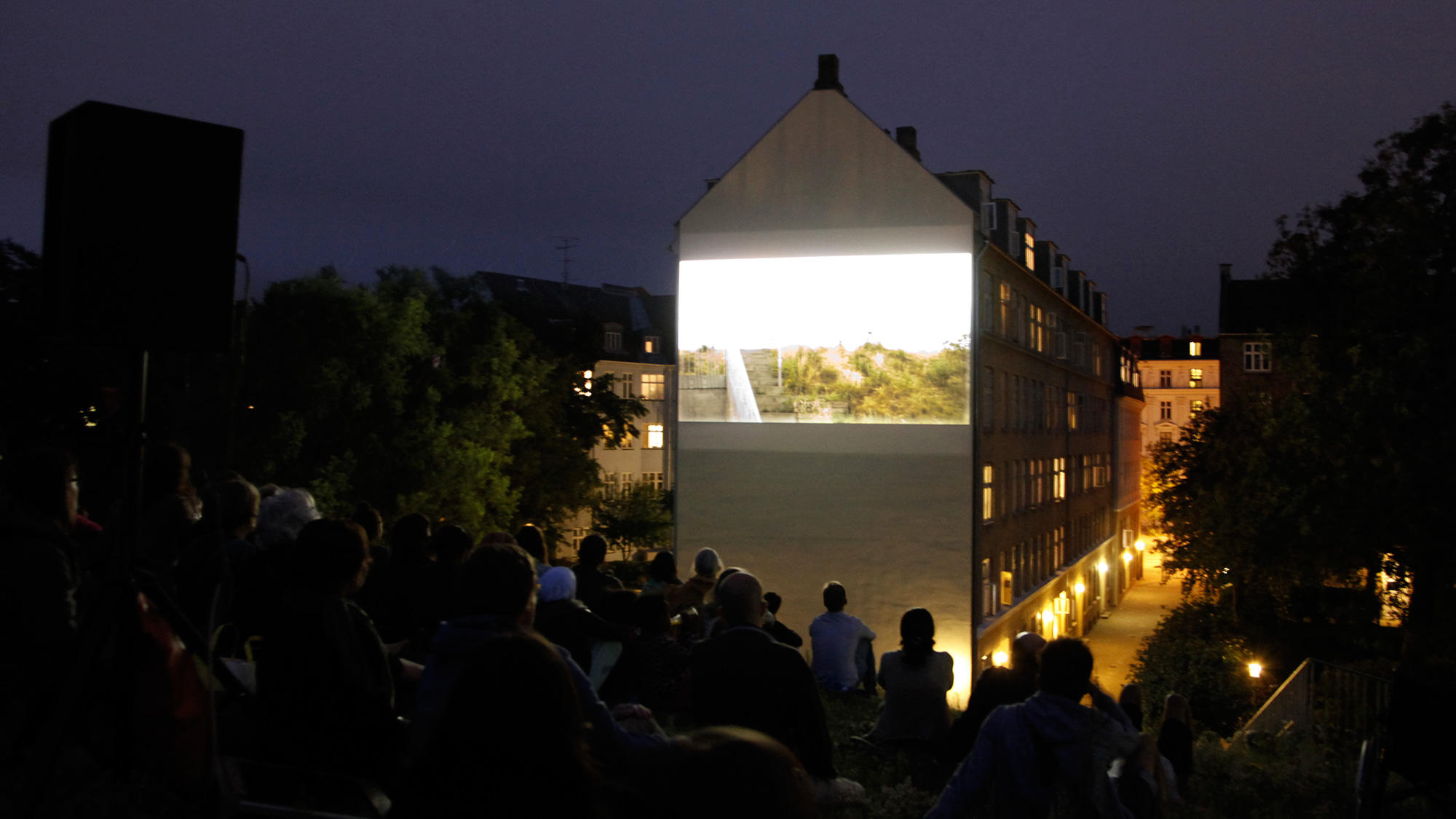 artists
artists
Fleeting Cities in Europe
Olivier Grossetête & Anna Rispoli (Zimmerfrei), interviewed by Quentin Guisgand, Ariane Bieou (IN SITU) and Jasmine Lebert (Lieux publics)
01/07/2013
Olivier Grossetête and Zimmerfrei collective (Massimo Carozzi, Anna de Manincor et Anna Rispoli) build “fleeting” cities. "Fleeting City" by Olivier Grossetête and "Temporary Cities" by Zimmerfrei are two IN SITU projects. As one creates common sense by building real cardboard walls, the other offers a dream version of the city.
Artists' reflection about the invisible walls dividing our towns.
Jasmine Lebert - Why are you working on the theme of the city and why are contemporary cities a source of inspiration for you?
Anna Rispoli - Cities define our condition as contemporary citizens. Not only because of demo-graphic facts and realities which show that the urban condition is a new way of being human but also because the nature of towns is constantly reshaping its definition. We are compelled to invent a new means of relating to other people: how can we forge a relationship with other human beings who are not only from different ethnic, geographical and language backgrounds but who also constitute vectors of other ways of living, other conceivable cities which coexist? We constantly range across several towns, several ur-ban dwelling conditions. Some are hidden whereas others are more visible. As far as we are concerned, we are interested in concealed, subterranean or more or less fleeting cities.
Olivier Grossetête - The town is where I live, where I have been born and raised. It engenders our behaviour patterns. Its organisation structures us. Cities are pregnant with semiotic symbols. I want to play with those signs. I started out with buildings and construction. My goal was to upset the fixed images of the city and suggest another way of living together. That’s why I became interested in architecture as a symbol of power. Working in public space means working in a specific relationship to others and therefore in power relations. One of my first artificial constructs consisted in juxtaposing two cardboard towers to a town hall. This clearly involved calling into question the symbol of power in order to subvert it with people’s help and a so-called 'poor' material.
Anna de Manincor - When we arrive in a new town, the first thing we do is to walk around and contemplate visible things. Afterwards we traverse the walls in our imagination. With a child’s imaginative power which consists in looking in at a window while believing it’s possible to see the whole of the flat. That’s how we come up with stories. These turn into short subterranean films fromwhich we can ascertain whether the pictorial representations which have welled up within us can crystalize out into reality or not. Our documentaries are not true documentaries. They do not explain or reveal, they are created constructs based on material data. The city is rather a material object which forces itself into our view.
Quentin Guisgand - Anna, you referred to “subterranean cities” in your work. What might constitute their “invisible walls”?
Anna Rispoli - I didn’t take part in the two documentaries of Copenhagen and Budapest. Therefore I can visualise them both in an internal and external way. But these invisible walls are also those of ones self-representation faced with the others. These documentaries impinge on the tangible limit between private and public spaces: self-representation in relation to the community and the boundaries defining this community. The great freedom of our documentaries lies in the possibility of imagining oneself elsewhere, in another place within a shared urban space. It’s by evoking and conjuring up these desires and these projections that we can reappropriate for ourselves these shared spaces.
Olivier Grossetête - In a city, what makes me suffer, is being in the midst of such a multitude of people and simultaneously feeling alone. The bigger the city, the greater ones loneliness, the harder it is to make real contact with others. It’s precisely there that rise our painful invisible walls. Thanks to my projects I visit different towns and each and every time I experience the same feeling of solitude. My procedural way of working doesn’t change from one town to another. It’s the relationship to space and shapes which changes. In order to break down these invisible walls I set up workshops which enable me to forge interpersonal links. Doing things collectively is a way to meet up with others. That’s my game plan. First of all, it’s “please hand me the cello-tape”, then, after a while, a dialogue ensues.
Quentin Guisgand - Is fiction a way to demolish these walls or to point them out, perhaps?
Olivier Grossetête - I create other walls to bring down these virtual walls. At least, for a while. We create links which surprise so as to propose something else and not necessarily to combat this. Art is there to put forward propositions which stand out some-what, to enable us to stand back from the city and re-assess our daily relationship with it.
Anna Rispoli - The most insidious invisible wall is perhaps the swampy territory of artistic reappropriation. We speak of city planning issues, urban development, or gentrification but the work that artists are called upon to do deals with wider issues and much more uncontrollable ones. We are aware of the stroke of genius behind the huge boom of the past few years in favour of art in public spaces, of this challenging appeal to artists to assume the mis-sion of revitalising social links in public spaces. This offers enormous scope to break down some walls. But it also harbours concealed within it things that we can’t manage to control, especially as the economics of performing arts doesn’t enable us to ma- nage the consequences of our actions in the long term. What does “temporary intervention” mean? What is the ethical and political responsibility of this type of action?
Olivier Grossetête - Of course, there is “what comes after” but I believe that if this type of action creates desire, then it is already good. Art is desire and desire is life. Saying to someone, “I need you” al-ready entails offering that person something and that can create desire.
Quentin Guisgand - There is movement in your work. How do you make your “fleeting cities” inhabited and livable?
Anna Rispoli - We create within a city a viewing point which is also a listening point. This is a position from which we endeavour to establish a possibility of something real, in which there is an unbelievable degree of chaos. So, how does this chaos traverse what is real? How does what is invisible become visible? We allow ourselves to be surprised by the gaze of strangers. In Copenhagen you chose a hill where you waited for something to occur…
Anna de Manincor - Yes and it’s the people themselves who approached us. I started by myself. I filmed nothingness; I framed within camera shot visions which could not be reduced to a sequence of dramatic narrative. It was precisely the opposite of an investigative film where you put questions to people, expecting answers that confirm an hypothesis. When someone becomes interested in the invisible thing that you are doing, they approach you and come up with stories to tell you without you having to ask them. Normally, people don’t appreciate being filmed unless they are already characters themselves. But we don’t film them directly. We frame a shot of a building and we speak with them about it. We are on the same side of the camera and we look in the same direction. The camera no longer represents a barrier. We construct a temporary, displaced reality. Therefore we can discuss our points of view on what was there previously that we can no longer visualise, what is in the process of being built that can’t yet be seen. It’s only after a while that I can begin to film the individual, his face and his body. This person then becomes the co-author of the film.
Olivier Grossetête - Movement in my constructions stems primarily from the fact that we construct them. We are involved in making them, that’s what creates the movement. From the outset, I wanted to manufacture my things by myself and master every-thing. But by bringing in other people I was forced to relinquish this control, which makes room for life. In my creative process, I arrive by myself in a town, try to meet people and motivate them, to single out the most capable ones to leave them responsibilities. I am alone and I suffer from this state. But this is also a strength. I’m attached to my solitude, it enables me to approach others. When there are two of us we form a less permeable entity. The fact of being alone makes you available for others.
Ariane Bieou - But the movement in your towns is also physical, as the buildings move…
Olivier Grossetête - I’m interested in the game of moving the buildings around. At Chalon-sur-Saône, where the ground was sloping, we had to shift the building to put it at the right level. It was rather a question of setting it up. But it was also beautiful. In Marseilles, for the first time I am gearing up to build-ing an entire city. We plan an average of five constructions per day. On the first day, we will perhaps try to make ten small ones which will grow when there are more people around. The construction won’t remain static. Improvisation will play a part. If the Mistral blows for three days we won’t be able to make very high buildings. We will be able to spread out the town and subsequently reach for the sky. Unmasterable stories will emerge from this.

Jasmine Lebert - How do you cope with the clash between public and private spaces in the building of your fleeting city? Is everything comprised of public space or is there space for the individual?
Olivier Grossetête - The space will be above all public since the act of building means gathering people together. Afterwards each individual will create his own story. The relationship to what is private lies rather in each person’s individual experience. Those who want to sleep in the constructions at night will be allowed to… but the safety issues are not obvious. As soon as you enclose a space, far-reaching security constraints arise. This involves allocating a budget to supervise the place in order to let the town come alive while also ensuring that there is no risk. In Marseilles we can’t leave the town unsupervised. But, ideally, the town will fend for itself and I don’t want to put up barriers at night. It must be an object that is free to escape itself from my control.
Quentin Guisgand - Your work is accompanied by the IN SITU network which means that you are sometimes led to cross international borders. What vision of Europe has this nomadic wandering in-stilled in you?
Olivier Grossetête - Every town has its very own collective energy. I will always be astonished by the way people behave. I made one of my first constructions at Annecy. After its destruction, we laid out all the cardboard and there was no adhesive tape left on the ground. If you do that in Marseilles it won’t be the same at all! Embarking on a construction site in Scot-land was a laborious undertaking. Then the experiment caught .
Anna Rispoli - The only time we really felt that we were Europeans was in New York. This notion of being European still defies definition. Establishing a link between European cities and tracing an identity from them? European identity is still a hazy thing for me. What is lacking in Europe is a history of the self, a shared personal narrative, akin to what exists in the United States of America. To achieve that, the Americans based their approach on a fictional identity, that of virgin land, of the New World…
Quentin Guisgand - And a European narrative comprising your Temporary Cities?
Anna de Manincor - Admittedly we convey with us a gaze which generates links. We turn up in a town, replete with suggestions that the previous city has in-spired in us. Then something like a transfer of these suggestions and desire takes place. Some arose in a town, petered out, then resurface in another town. In Budapest we looked for skeletons of buildings, whose structure can be perceived from the outside. As we found none, the underground film shifted to phantom buildings.
Anna Rispoli - But we did indeed find some in the rue de la République, here in Marseilles.
Anne de Manincor - Yes and we’ll continue talk-ing about Budapest now we are in Marseilles and we will speak about Marseilles when we will travel elsewhere. We drag from place to place, perpetuate within ourselves subjects which are undoubtedly anachronistic.
Translated by Sarah Jane Mellor
publié dans « Murs invisibles », coédition Lieux publics, IN SITU et la revue Mouvement, cahier spécial n°70 juillet-août 2013 © mouvement 2013
>> download the whole magazine (see article page 35)
 Temporary Cities, The Hill, Zimmerfrei © Thomas Seest
Temporary Cities, The Hill, Zimmerfrei © Thomas Seest